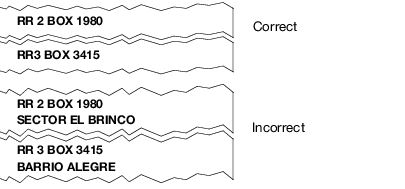The components of the Delivery Address Line are the Urbanization (when required), primary address number and street name, secondary address identifier, and secondary address range.

Note: In Puerto Rico there are usually no directionals or suffixes. Additionally, some apartment buildings do not have a street address. In this situation, the building name is part of the primary address identifier. If directionals are present in an address, they are part of the street name. Do not translate to directionals.

Note: See Appendix I for additional information regarding Addressing Standards for Puerto Rico. See Appendix J for additional information regarding Addressing Standards for U.S. Virgin Islands.
Do not abbreviate street names if at all possible. Consult the abbreviation tables prior to making any abbreviation. For matching purposes, eliminating the word CALLE from named streets is recommended. Always print CALLE, AVENIDA, etc. on the mailpiece.

Numbered streets must always contain the word CALLE. This avoids misinterpretation of the delivery information between numbered streets and house numbers.
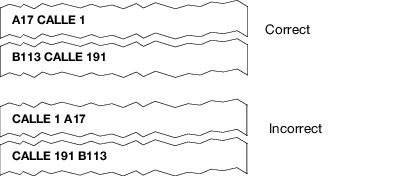
Note: Do not translate CALLE to the suffix ST. This translation makes the address undeliverable.
House numbers may have fractional or alphabetic modifiers. To make an address more deliverable because of alphanumeric ranges, place the house number before the street name.

Due to the amount of numbers within a block and a house number in Puerto Rico addresses, many identifiers are used to separate address elements, including BLOQUE, NUM, NO, CASA, and LOTE. None of the identifiers are part of the address, and they are not in the AIS files.
Certain rules have to be established to eliminate these identifiers from address files. Placing the house number before the street name is recommended.
When placing alphanumeric house numbers prior to the street name, avoid using hyphens.
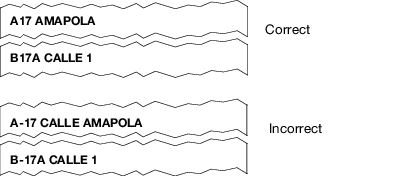
However, hyphens in the address range may be significant. When addresses contain up to three–digit numeric block numbers, it is necessary to include a hyphen.
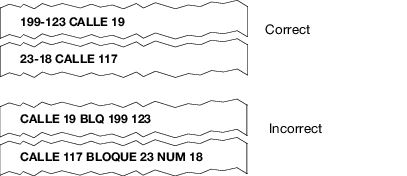
This process facilitates matching customer files against AIS since hyphens are present in the AIS files.
Urbanizations are an important part of the address. They are abbreviated to URB followed by the urbanization name.

Urbanizations are not repeated within five–digit zones and in most cases are served by one single carrier route. Therefore, a list of urbanization names serves for Five–Digit ZIP Code verification.
Note: Certain urbanizations are known as extensiones, mansiones, repartos, villas, parques, and jardines. When these names are present, there is no need to place the abbreviation URB prior to the name of the urbanization.
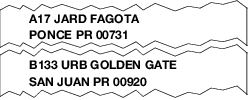
Note: Some areas in Puerto Rico served in urbanizations do not have a street name. The urbanization becomes a street name and is located in the primary identifier of the AIS files.
Print Post Office Box addresses as PO BOX on the mailpiece.

PO Box addresses often appear with the words CALLER, CALL BOX, GPO BOX, PO BOX S–1190, APTDO, APARTADO, BOX, BUZON. These are changed to PO BOX as output to a mailpiece.
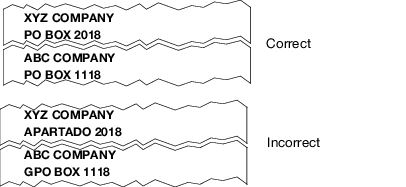
In certain areas, the station name appears in the line above the city, state, and ZIP Code. We recommend that it is either eliminated from the output address or relocated, placing PO BOX above the city and state and placing the station name on the line above. Station names are not present on the ZIP+4 file.
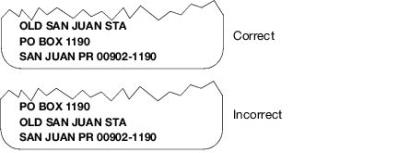
The rural route address on a mailpiece must be standardized as follows: RR ## BOX ## (in this example, “##” indicates the actual number or numbers).

Note: Do not use the words RURAL, RUTA RURAL, BUZON, or BZN. A leading zero before the rural route number is not necessary.

The designations RFD, RD, and RT (meaning rural route) are changed to RR.

There should be no additional designations, such as sector names, on the Delivery Address Line of rural addresses. Sector names used together with route and box numbers can create potential matching difficulty. Mailers are encouraged to use only one style of addressing. Eliminate this information in Puerto Rico addresses.
